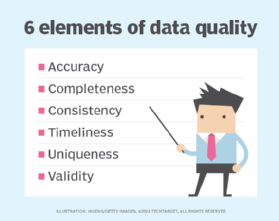
your123 - stock.adobe.com
Data quality in AI: 9 common issues and best practices
Building a useful, reliable AI system requires trustworthy, well-managed data. Here's how to find and fix data issues that can drag down AI projects.
When AI projects fail, it's often not because of the algorithms -- it's because of the data.
Data quality problems can rapidly derail an AI initiative, even if other aspects of the project are well planned. Mislabeled data points, an unbalanced sample or difficulty accessing stored data can lead models to generate incorrect predictions or fail after they've been deployed to production.
Unfortunately, these challenges aren't always obvious at the outset, which can lead teams to waste time and resources developing models that don't work as intended. That's why understanding data quality issues is essential for AI projects: By planning to prevent common problems, AI teams can build more reliable, scalable and safe systems.
9 common data quality issues in AI projects
Understanding potential problems is an important early step in an AI project. Explore nine of the most frequently encountered data quality issues, such as biased or inconsistent data, sparsity and data silos.
1. Inaccurate, incomplete and improperly labeled data
Many AI projects fail because their models rely on inaccurate, incomplete or improperly labeled data. Source data must be cleaned, prepared and labeled correctly.
Data cleanliness is such an issue that the data preparation industry emerged to address it. While it might seem straightforward to clean gigabytes of data, imagine having petabytes or zettabytes to clean. Traditional approaches don't scale, which has resulted in new AI-powered tools to help spot and clean data issues.
2. Too much data
Because data is crucial to AI projects, you might think that more data is always better, but you can have too much data.
A portion of data is usually unusable or irrelevant. Having to extract useful data from a more extensive data set wastes resources. Extra data might result in noise that can cause machine learning systems to learn from nuances and variances in the data rather than the more significant overall trend.

3. Too little data
On the flip side, having too little data presents problems.
Training a model on a small data set might produce acceptable results in a test environment. However, bringing a model from a proof-of-concept or pilot stage into production requires more data. In general, training on small data sets can produce models that demonstrate low complexity, bias or overfitting, leading to inaccuracy when working with new data.
4. Biased data
Data can be selected from more extensive data sets in ways that don't accurately convey the trends or distribution of the broader data set. In other ways, data could be derived from older information that might have resulted from human bias. Or there could be some issues with how data is collected or generated, resulting in a biased final outcome.
5. Unbalanced data
Although everyone wants to minimize or eliminate bias from their data, this is much easier said than done. Unbalanced data sets can significantly hinder the performance of machine learning models by overrepresenting data from one community or group, while unnecessarily reducing the representation of another.
Some approaches to fraud detection use unbalanced data sets. Most transactions are not fraudulent, so only a small portion of a data set represents fraud. If a model trained on this fraudulent data receives significantly more examples from one class versus another, the results will be biased toward the class with more examples. Conducting thorough exploratory data analysis is essential to discovering and solving such issues early.
6. Data silos
Related to the issue of unbalanced data is the issue of data silos, where only a certain group or a limited number of individuals in an organization can access a data set. Data silos can result from technical challenges, restrictions in integrating data sets, or issues with proprietary or security access control of data.
Data silos are also the product of structural breakdowns at organizations where only certain groups have access to certain data, as well as cultural issues where lack of collaboration among departments prevents data sharing. Regardless of the reason, data silos can limit the ability of those at a company working on AI projects to gain access to comprehensive data sets, possibly lowering the quality of results.
7. Inconsistent data
Not all data is created equal. Just because you're collecting information doesn't mean you can -- or should -- use it. Training a model on clean but irrelevant data results in the same issues as training systems on poor-quality data.
Inconsistent data goes hand in hand with irrelevant data. In many circumstances, the same records exist multiple times in different data sets but with different values, resulting in duplicates and inconsistencies. When dealing with multiple data sources, inconsistency indicates a data quality problem.
8. Data sparsity
Data sparsity occurs when data is missing or when a data set contains insufficient specific expected values. Data sparsity can affect the performance of machine learning algorithms and their ability to calculate accurate predictions. If data sparsity is not identified, it can result in models being trained on noisy or insufficient data, reducing the effectiveness or accuracy of results.
9. Data labeling issues
One of the fundamental types of machine learning, supervised machine learning, requires data to be labeled with correct metadata for machines to derive insights. Data labeling is complex and requires human resources to put metadata on various data types. This can be complex and expensive.
Improperly labeled data is a challenge for in-house AI projects. Accurately labeled data ensures that machine learning systems establish reliable models for pattern recognition, forming the foundations of every AI project. Good-quality labeled data is paramount to accurately training the AI system on the data it is being fed.
Why is data quality important in AI projects?
Data quality is foundational to the success of AI projects because it directly affects machine learning models' accuracy and reliability. High-quality data helps AI systems learn accurate patterns and generalize well to new information, leading to better performance in real-world contexts. Conversely, low-quality data leads to higher error rates, poor pattern recognition and inconsistent decision-making.
Improving data quality can also make AI applications and services more efficient and scalable. Managing issues commonly found in low-quality data, such as handling missing values or correcting erroneous data points, can be time-consuming and expensive. Clean, well-structured data needs less preprocessing, which speeds up model development and deployment.
Beyond accuracy and efficiency, data quality is also essential for ensuring fairness in AI models. Addressing biases in training data requires careful data curation practices, such as representative sampling and rigorous validation. Transparency in data documentation and management practices also promotes model interpretability and explainability, which help model development teams, end users and other stakeholders better understand AI systems' decisions and outputs.
6 best practices to ensure data quality for AI projects
Data quality issues should be addressed at each stage of an AI project. Here are six best practices to follow throughout the model lifecycle.
1. Be strategic when collecting data
Data quality starts with data collection. When gathering data for an AI project, choose data sources that are representative, reliable and directly relevant to the project's goals.
Whenever possible, look for real-world, diverse data, rather than relying heavily on narrow or synthetic data sets; this reduces the likelihood of overfitting and bias. And, during the data collection process, carefully document the origins of your training data to facilitate debugging down the line and to promote model transparency.
2. Carefully clean and preprocess data
Well-curated data isn't enough; you also need to make that data easy for machine learning models to use. Thorough data cleaning and preprocessing have many benefits for model training, including reducing noise and improving model accuracy.
Essential data cleaning and preprocessing steps include the following:
- Identifying and handling outliers and missing values.
- Removing duplicate data points.
- Correcting inaccuracies.
- Standardizing data formats to ensure consistency.
- Normalizing or scaling features.
3. Proactively check for and mitigate bias
Bias due to unrepresentative or skewed data sets can compromise an AI system's reliability and performance. Assess data sets for various types of biases -- demographic, sampling, geographic and so on -- using bias audits and exploratory data analysis. Catching and correcting model bias early on results in more effective and trustworthy AI systems in the long term.
Keep in mind that bias doesn't just refer to discrimination against a specific group, though that's often what most people associate with the word. If an e-commerce company were to primarily train a demand prediction model on data from the end of the calendar year, it would be biased toward holiday shopping patterns -- potentially overestimating demand for seasonal products and gift items, while underestimating demand for everyday purchases.
4. Automate data validation
Incorporating automated validation into data pipelines helps avoid costly corrections down the line, keeps data reliable and reduces the amount of tedious manual labor required from data teams.
The following are a few key checks to implement:
- Schema verification to make sure that data fits the expected structure.
- Statistical validation to automatically look for outliers or unexpected distributions.
- Anomaly detection to flag atypical data points using rule-based or machine learning methods.
5. Label data transparently and consistently
Many AI projects rely, at least to some extent, on data labeled by humans -- sometimes fully manually, sometimes in the form of oversight over software labeling decisions. The quality of those data labels can greatly affect model success. Disagreements or inconsistencies among data labels and annotations can create confusion during model training and impair a model's ability to accurately classify data points or learn patterns.
To avoid these problems, develop clear labeling guidelines that are easy for teams to follow. Include examples for each data category, and provide processes to follow when labeling ambiguous data or edge cases. Team leaders should periodically check in with annotators to ensure that everyone's on the same page and that the labeling standards still make sense as the project evolves.
6. Manage data drift with continuous monitoring and retraining
Data quality isn't just a consideration at the beginning of an AI project; it's an ongoing concern that teams must revisit over time. After the model is live, keep track of how it's doing in production because user behavior and the characteristics of the model's real-world environment will likely change over time.
This can lead to a phenomenon called data drift, where new real-world data looks less and less like the data the model was originally trained on -- and, therefore, the model becomes less and less accurate. To address this problem, use model monitoring and observability tools to keep track of key metrics that could signal data drift, such as the following:
- A drop in important model performance metrics, like accuracy, recall, precision or F1 score.
- Notable differences between incoming data and training data distributions.
- Sudden increases in outliers or error rate.
When you notice data drift, update or retrain the model on new, relevant data to keep the system accurate and reflective of the world around it. This process can be standardized as a part of MLOps pipelines using observability tools, such as Arize AI or customized Prometheus dashboards, and tools for automating retraining pipelines, such as MLflow and Kubeflow.
Editor's note: Kathleen Walch first wrote this article in 2020. Lev Craig updated it in 2025 and expanded it, writing a new introduction and additional sections on the importance of data quality in AI and best practices for ensuring data quality.
Lev Craig covers AI and machine learning as site editor for SearchEnterpriseAI. Craig graduated from Harvard University with a bachelor's degree in English and has previously written about enterprise IT, software development and cybersecurity.
Kathleen Walch is director of AI engagement and learning at Project Management Institute.





